On April 11, 1912, the Titanic departed Cobh, formerly known as Queenstown, in Co Cork, and set sail for New York. Today The Titanic Experience at Cork harbor commemorates the Irish passengers who boarded the ship at Titanic's last port of call.
In the dark, on the first night of September, the bells of St. Colman’s ring out over the peaked rooftops of Cobh. The notes, pure and deliberate, linger over the quiet waters of Cork Harbor below.
Liam and I are on the roof deck of the Commodore Hotel. He is my son, and he is seven. The deck is a short bit of hallway and two steps up from our room, which has such a perfect view of the harbor that its two tall windows might as well be paintings hanging on the wall, the work of an artist with an eye for cloud-bearing light.
A brief rain has left the picnic tables on the deck damp so I remain standing while Liam lopes back and forth, back and forth. As the chimes ring, I call to him and point to the cathedral, miles away, atop a steep hill.
While walking up Fifth Avenue in Manhattan, St. Patrick’s startles, as though the cathedral has suddenly stepped forward from the gray gathering of office buildings that surround it. Not so St. Colman’s. From the moment we got off the train from Dublin a day earlier, it drew our gaze. Wherever we go in Cobh, St. Colman’s is there. Imagine what it must have been like to watch it appear on the hillside, stone by stone over forty-seven years, a slowly manifesting angel.
Now St. Colman’s is gently illuminated, which makes the two clocks on the spire glow. Below the cathedral, a sparse starscape, the lights of the town. Beyond, only night.
Liam and I have come outside so Travis, my husband, his father, can get some work done by dawn, New York time. And Liam needs to stretch his legs. We live in a four-room apartment in Brooklyn. He takes his space where he can get it. Liam, tall for his age, quickly shifting from puppy to colt. His eyes are the exact blue of my own, and my father’s and those of my grandfather, who was born in Tuam, Co. Galway in 1906. My grandfather left Ireland at the age of nineteen. My grandmother, from Ballinasloe, emigrated a few years later. Both, like thousands of Irish before them, and thousands after, traveled to Cork to sail from Cobh Harbor.
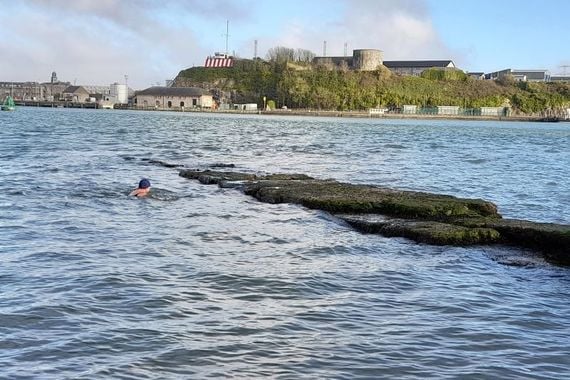
The American pier at Cobh, County Cork.
Had either left only a few years earlier, their tickets would have said Queenstown. In 1849, Queen Victoria paid a visit, her first-ever trip to Ireland, and Cobh was renamed to commemorate the occasion. Those with even a glancing knowledge of Irish history will recognize 1849 as a hunger year. Mass starvation and death, eviction, and emigration. It’s difficult to reconcile this with a royal visit. Indeed, after the Irish Free State was established in 1922, Queenstown was replaced with a Gaelicized version of its former (English) name, Cove. And so Cobh was the last my grandparents saw of their homeland, Edward, for decades, Una forever. They would meet and marry in Brooklyn.
Yet it is not our own ghosts that we have come here to find.
I walk to the railing of the roof deck of the Commodore and look left up the street. There, just in sight, is a building, unassuming but for the red flags, embossed with a white star. I call Liam over and point. He looks left.
“That’s the museum,” I tell him. “That’s where we were today.”

Are you planning a vacation in Ireland? Looking for advice or want to share some great memories? Join our Irish travel Facebook group.
The building once housed the local offices of the White Star Line, the renowned British shipping company. On April 14, 1912, Titanic, the gem of its fleet, struck an iceberg on its maiden voyage. The collision happened at 11:40 pm. Within two hours, the ship at once sank to the sea and rose to legend. Approximately 1,500 people died; 706 survived.
I can’t recall why I first mentioned Titanic to Liam but I do know he was instantly fascinated, exactly as I had been when I was eleven and, while browsing in the library, stumbled across A Night to Remember, Walter Lord’s seminal book about the tragedy.
I showed Liam the sinking sequence from James Cameron’s 1997 movie, Titanic. He now has it memorized. He’s also read several children’s books about Titanic. He can name each officer and say who survived and who did not. He can tell you that most of those lost were in Third Class and that a great many of them were Irish.
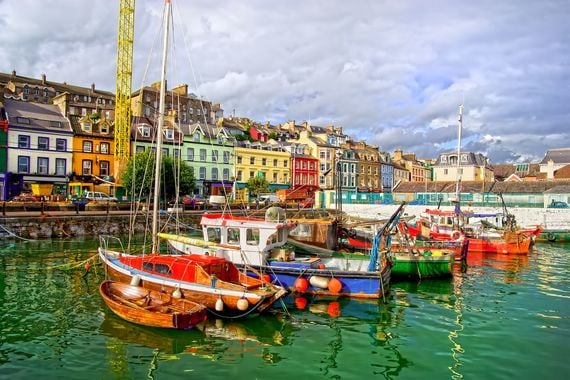
Fishing boats at Cobh.
Titanic was built in Belfast and sailed to Southampton, England, for the official start of her maiden voyage. From Southampton, she went to Cherbourg, France where 281 passengers boarded. On April 11, Titanic arrived in Cobh Harbor, its final port of call. Eight passengers disembarked and 123 boarded.
On the roof deck of the Commodore, Liam bounds off and as I continue to contemplate the museum. Cork was not part of our original itinerary for this trip. We added it at the last minute, for Liam. Given his interest, it seemed unfair to come all the way to Ireland and not touch Titanic. Belfast, where the ship was built and where there is a very big museum and memorial, was not remotely an option. Cork we could manage, though only just. It meant one day in Galway instead of three. Travis said we should because who knew when we’d be back in Ireland?
I agreed, yet my own decision was made both as a parent and as a novelist. I’ve written about real-life tragedies and I know what means to visit a location where lives were lost and how, if you try, you can double-see. The place as it is now and as it was that day, that night, that hour. I understand what it means to say, I know what happened here and I see you. Though Liam is too young to grasp this, he will have the memory to keep.
***
Each ticket to Titanic Experience, Cobh was a replica of a Third Class boarding pass with a passenger’s name on it. At the very end of the tour, we were told, we could check the list of Irish who boarded the Titanic at Queenstown and see if ‘we’d’ lived or died.
My name was Kate Mullen. My husband was Patrick Canavan and Liam, Eugene Daly. The boarding passes were dated April 11, 1912. In small print, there was a menu of the three meals a day provided to the Third Class passengers, who were not allowed in the Titanic’s lavish restaurants.
The tour guide was respectful, but not overly grave. She led us to exhibits of passengers’ quarters: a sepia-lit, First Class stateroom, and then a replica of Third Class, or steerage, quarters. The contrast was striking, like looking at a luxury hotel suite and then a dorm room. Behind a velvet rope, there was a set of bunk beds and a basin for washing. A pair of shoes sat on the floor.
We climbed a flight of stairs and filed outside onto a narrow balcony that overlooked the harbor. Here, the guide informed us that Titanic did not actually sail into Cork Harbor. The ship was too large. It dropped anchor behind Spike Island, which has, over the course of its history, been the site of a monastery, a fort, and a prison.
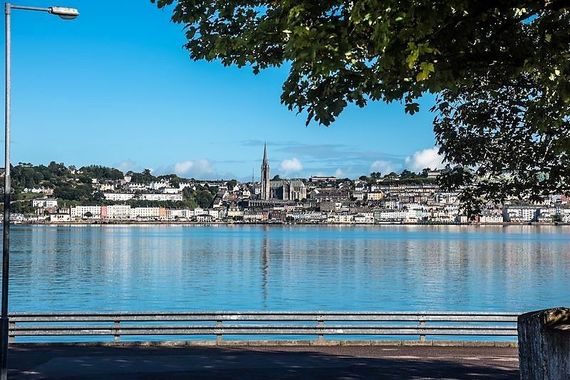
A view of Cobh from Spike Island.
Passengers were brought to and from Titanic on two small boats called tenders. The guide pointed out the pier from which the passengers boarded the PS Ireland and the PS America. It is the very pier that was in place over a century ago.
Once the guided part of the tour was done, including a short film watched while sitting in a replica of a lifeboat, we were free to stay in the museum for as long as we liked.
There is an exhibit dedicated to Margaret Rice and her five sons, which startled me because I recalled reading their names in the Passenger List index that concludes Walter Lord’s A Night to Remember. Their names were not italicized, which meant they’d died. After each of the boys’ names: (CHILD). They are not otherwise mentioned in the book. I had not known they were Irish.
Margaret was a widow. Her oldest son was ten and the youngest, two. As later reported by a fellow Third Class passenger, the Rice family were last seen on deck, Margaret holding the baby as her other boys clung to her skirt.
One-hundred and fifty of Titanic’s lost are buried in Nova Scotia. Margaret Rice is one of them, identified by a pillbox with her name on it, recognized as Catholic by the rosary in her pocket. If found, Albert, George, Eric, Arthur, and Eugene Francis were never identified.
There is an exhibit dedicated to the Addergoole Fourteen, the men and women from the parish of Addergoole in County Mayo who sailed together on Titanic. Eleven of them died. And so Addergoole bears the tragic distinction of having lost the most people on Titanic, proportionally. That is, the number lost in direct correlation to its population. Most of the groups were related to each other. Husband and wife. Brother and sister. Aunt and niece. Several were cousins. Every April 15, in Addergoole, bells are rung in memory of those who were lost over a century ago, a tradition carried on by the Addergoole Titanic Society.
As for the passengers on our boarding passes, Kate Mullen survived. She went on to work as a domestic in New York City and later married and had four children. She is buried in St. Raymond’s Cemetery in the Bronx.
Eugene Daly saved two Irishwomen, one of them his cousin, by convincing them to go up on decks to get in a lifeboat when neither believed they were in danger. Eugene went down with Titanic, washed overboard at the very end. He survived by clinging to the overturned Collapsible B lifeboat through the night. He married and had one child, a daughter, and eleven grandchildren. Eugene Daly is also buried in St. Raymond’s Cemetery. His gravestone says, ‘Titanic Survivor.’
Patrick Canavan was one of the Addergoole Fourteen, on his way to join his sister in Philadelphia. He was lost. One of the Addergoole survivors credited Pat and another man with guiding many of their group to the deck where the lifeboats were launching. If his body was found, it was not identified.
Quietly, we left the museum.
***
The bells of St. Colman’s ring again.
They remind me that it’s getting late and Liam needs to get to bed. Tomorrow, we are leaving Cobh, catching a train to Portlaoise. But I wait a few more minutes until the bells finish. Below, a small boat passes by, rippling the moonlight on the night-black water.
Titanic set sail at 1 o’clock in the afternoon. According to the online Encyclopedia Titanica, many of the Irish passengers attended morning mass at St. Colman’s. (Encyclopedia Titanica cites "The Irish on the Titanic" by Senan Murphy as its source.)
Cove-Queenstown-Cobh has a third name, a nickname of sorts. The saddest place in Ireland. This refers, of course, to the Irish who emigrated and to the families left behind.
Outwardly, there is nothing remotely morose about Cobh, a garden of a town with rows of colorful buildings. Yet if you dip down into it, I think the sadness is there, like a humming you can’t hear unless you listen for it. Not the ringing of bells, but the vibration left behind.
The intimate, respectful museum to Ireland’s losses on April 15, 1912, speaks to this. In reference to the Titanic, Irish is very often synonymous with steerage or even shorthand for it. A typical, off-the-cuff recitation of Titanic passengers, the survivors, and the dead, usually goes like this: Astor, Guggenheim, Strauss, Duff Gordon. It’s never, Rice, Canavan, Daly, Mullin, Donohoe. The power of Titanic Experience, Cobh is a simple acknowledgment. I see you.
The pier that Titanic’s Irish passengers crossed isn’t visible from the roof of the Commodore. But though I can’t see it, I envision how it must appear in the dark. All the structures that can be seen from the water’s edge of Cork Harbor, the older ones and the more recent, are well-tended: the hotels, pubs shops, restaurants, JFK Memorial Park, directly across from the Commodore Hotel. The pier, in contrast, is notably stark. A pier-skeleton. Of the 123 men, women, and children who boarded the Titanic at Queenstown, 79 were lost.
Imagine their ghosts crossing the pier for eternity. Better to haunt Cobh than the lonely Atlantic. Return to the very last place where your life might have been saved. Stay for the chance that time might deliver you back to April 11, 1912, where a voice can call down through the century, turn back.
* Originally published in April 2018, last updated in April 2023.
This article was submitted to the IrishCentral contributors network by a member of the global Irish community. To become an IrishCentral contributor click here.
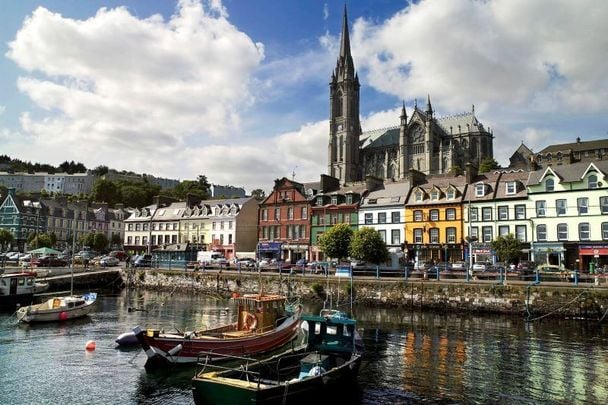
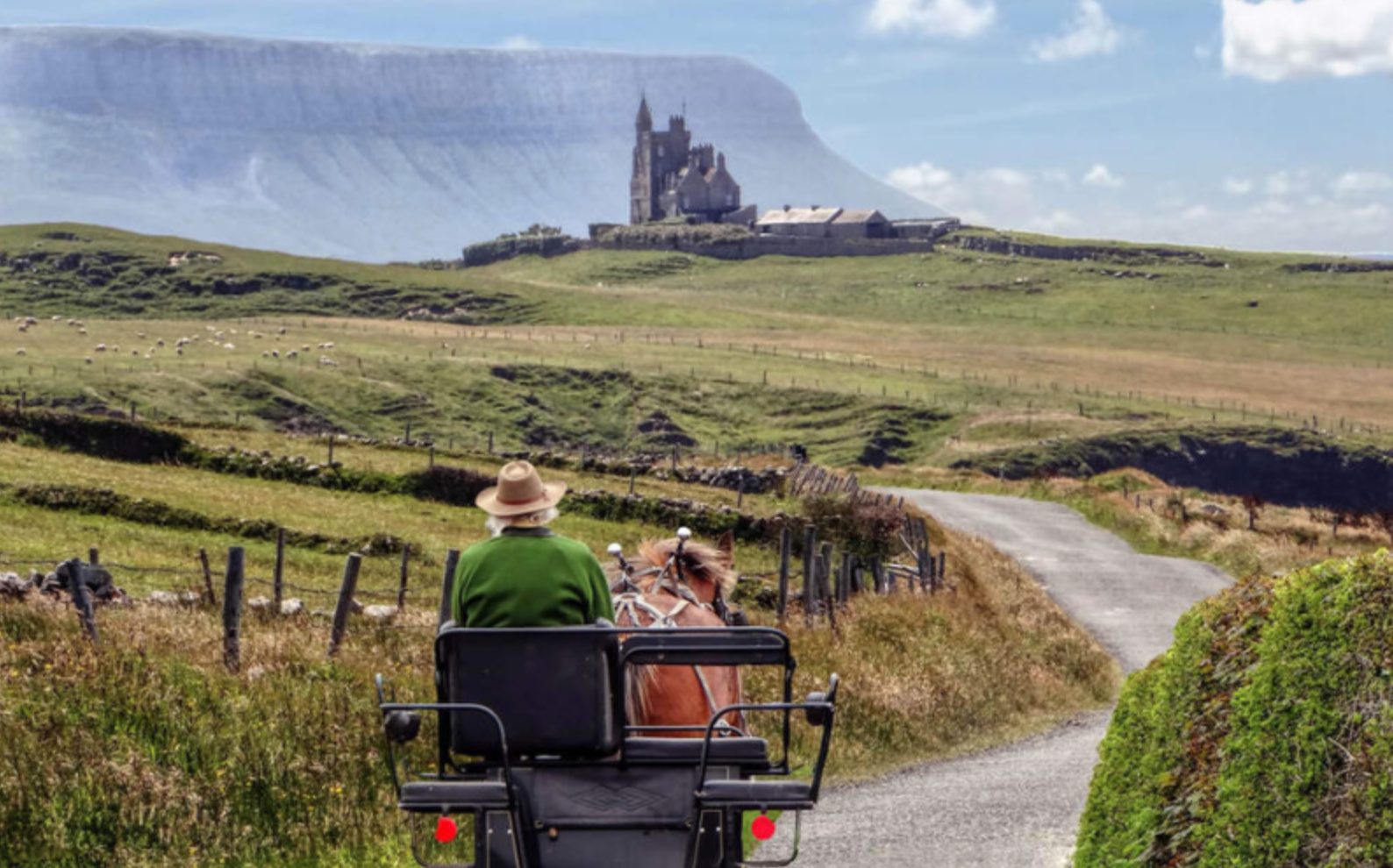


Comments